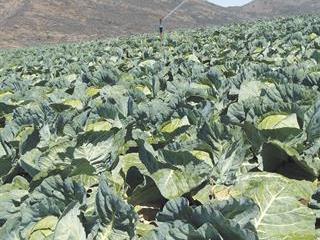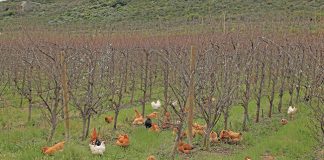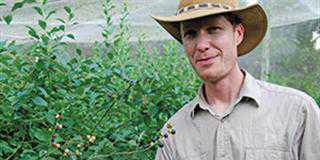
“Nothing prepares you for farming like experience does – no rule book, no text book – nothing,” says Brad Turner (27) about the importance of practical know-how when producing vegetables, today the productive mainstay of Mountain Glen farm’s 900ha. Brad returned to the family farm on the request of his parents Ian and Vinette after his dad fell ill. Brad had just finished two years of an agricultural diploma at the former Port Elizabeth Technikon, but was granted special permission to continue with his practical on the farm, returning to Mountain Glen in 2005.
Swallow your pride
With no production experience, Brad asked established farmers who had plenty of it, like local retired vegetable farmer Terry Burger and former vegetable farmer Dux Meintjes of Lone Oak Seedlings from East London. “You have to put your pride in your pocket and say listen, I actually know squat about what I’m doing – so teach me,” he says.Brad then assessed his productive options. “I had a look at the options, and weighed up vegetables and stock. I realised with stock it was going to take me 10 to 20 years to get somewhere and on a small place it wasn’t viable.”
So Brad took a bond on the farm to generate working capital and planted 4ha to 5ha of cabbage next to the Klaas Smits River, under dragline irrigation. Since then, he’s slowly expanded his operations to 80ha under irrigation. “I planted a crop, paid it off and went on, and each year I’ve been expanding. It’s basically been veggies that have kept me going,” he says.
Today his primary crop is cabbage and he produces 1,6 million a year, which is 75% of the total turnover from his vegetable operations. The other 25% comes mostly from tomatoes and butternut, but also from carrots, green peppers, spinach, gem squash, pumpkin, beetroot and on occasion, green mealies.
He says cabbage is always in demand as a staple food. The plants will survive through winter, thereby minimising the impact of seasonality that restricts many other vegetables. “What you see on the land has been pampered and looked after through the winter,” he says, pointing to his cabbage crop. “Then we kick off in September with tomatoes, peppers, butternut, gem squash, pumpkin, spinach, carrots and beetroot. It’s taken a good five years to realise what works when, and how, and this will probably continue with seasons changing.”
Permanently employed driver Gert Heath transports all produce with a recently acquired Isuzu 14t truck to local and regional markets. Of this fresh produce, 60% ends up on the shelves of vegetable wholesalers and various chain stores in Queenstown, while the remaining 40% is marketed through King William’s Town and East London municipal markets and on to shops and chain stores in the former Transkei.
Managing integration and costs
Brad plants about 40ha of mixed oats, barley and ryegrass as a rotational crop that’s used to supplement his livestock, thereby increasing the farm’s carrying capacity. Over 400 Dohne Merino ewes are crossed with SA Mutton Merinos, with 200 of these being managed on a progeny-share basis with partners, as are 100 Nguni cows. The 50 Beefmaster cows are his.
The mixed oats crop also serves as a valuable supply of green manure when ploughed back into the future vegetable lands. “We do quite a bit of green feed which we use as green manure for the veggies. I do supplement my stock with it, but the first growth that’s exposed after the first grazing gets worked back in.” The use of green manure along with chicken litter, purchased and used according to its unique nitrogen (N), potassium (P) and phosporus (K) content, can decrease fertiliser costs that in certain cases can amount to 50% of production costs of certain vegetables.
As for his spraying regimes, Brad says he believes in continually monitoring his crops for signs of disease or pests – such as cabbage moth and diamond-backed moth – and treating only if and when signs are discovered, to save on spraying costs. “We don’t spray blindly. I’d say spray for what you have to, and when you have to.”Although Brad plans to expand his irrigated lands by 60ha, and to erect tunnels in the face of strict state legislation on water usage, he’s accepted that water will have to be used more efficiently and effectively. “With government becoming more sticky on water, we’re trying to become more efficient in terms of water usage and we’ve recently acquired a probe system for the continual monitoring of water usage.
It all gets downloaded onto a software package (DFM Software Solutions CC), so you can determine what your usage is on a weekly and daily basis,” he says. Furthermore, Brad says the monitoring of water usage is critical in guarding against the dangers of over irrigation that can increase plants’ susceptibility to disease. “If you over irrigate you create anaerobic conditions that can result in disease outbreaks,” he says. “I would say a good percentage of farmers actually over irrigate.”
Effective mechanisation
Vegetable production is labour-intensive and Brad currently employs 45 permanent staff who live on the farm and 30 seasonal staff at any given time. Although he firmly believes in the importance of efficient labour, which he monitors through the software programme Access People Software, on his farm, he also believes in the importance of effective mechanisation to improve the efficiency of key management procedures. For example, in his second year back on the farm he decided to do away with the hordes of casual labour he hired to plant cabbage seedlings. He opted instead for a mechanical planter that he says has been a revelation.
Today he can perfectly plant 35 000 cabbage seedlings in eight hours with a tractor, planter and six workers, whereas in the past it took 35 highly efficient workers the same time to plant the same amount. Also, the army of workers need to be managed, transported and continually supervised to ensure efficient planting. In the end, he says it not only proved cheaper but it was more effective and far less stressful to invest in the mechanical planter. “Planting was costing me too much in labour. What I saved on labour could’ve paid off a piece of equipment with half the headaches and problems,” he says. “The more you mechanise, the further you’re going to get.”
But he points out that the mechanical planter wasn’t the only positive change in his farming.
His mindset on the cost of upkeep of ageing machinery also changed the way he farmed, and may be best illustrated by the fact that the first tractor he bought has now been replaced by five Massey Ferguson tractors. “I started with a clapped-out Fiat. I fixed it up and it was costing me major money a month. I thought that the money I was paying the mechanic could be used to buy new and pay hire purchase,” he says. “I’m still growing and have a lot of debt to pay off, but I believe that if you want to do something, you should do it properly the first time or it’s going to cost you double in the end.”
Contact Brad Turner on 082 516 6580. |fw













